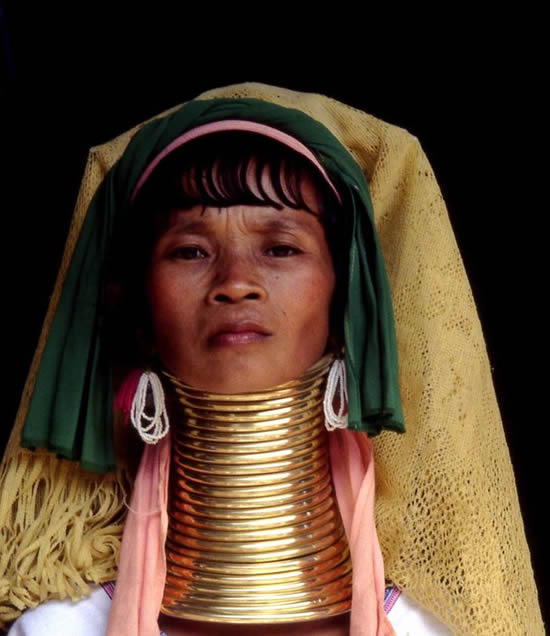The Extraordinary Tale Of The Longest Human Neck
Throughout history, the human body has exhibited a fascinating range of variations and adaptations, but few traits capture the imagination quite like the longest human neck. This unique characteristic has sparked curiosity and wonder across cultures and generations, as it challenges our perceptions of beauty, functionality, and even identity. From ancient civilizations that revered elongated necks to modern discussions surrounding body modifications, the longest human neck tells a story of both physical and cultural significance.
The phenomenon of long necks is perhaps most famously associated with the Kayan Lahwi women of Myanmar, known for their tradition of wearing brass rings around their necks. This practice is not merely an aesthetic choice; it embodies a rich cultural heritage that has persisted for centuries. As we explore the life of the individual who holds the record for the longest human neck, we delve deeper into the intersection of culture, biology, and personal identity.
The longest human neck is more than just a physical trait; it is a symbol of endurance and resilience. This article aims to unravel the life story of the individual with the longest human neck, examining both the personal and cultural dimensions that shape this extraordinary characteristic. Through this journey, we will uncover the biological, social, and psychological implications of having such a distinctive feature, shedding light on the experiences that accompany it.
Who Holds the Record for the Longest Human Neck?
The individual who is recognized for having the longest human neck is a remarkable woman named **Zhang Jinqing**. Born in 1975 in China, Zhang has garnered attention for her astonishing neck length, which stretches to an impressive **15 inches**. Her unique physical characteristic has not only inspired awe but also raised questions about the impact of such an exceptional feature on her life.
What is Zhang Jinqing's Biography?
| Attribute | Details |
|---|---|
| Name | Zhang Jinqing |
| Date of Birth | October 6, 1975 |
| Nationality | Chinese |
| Notable Achievement | Record for longest human neck |
| Height | 5 feet 4 inches |
| Interests | Fashion, cultural exchange |
How Did Zhang Jinqing Develop Such a Long Neck?
Zhang Jinqing's exceptional neck is a result of a combination of genetics and environmental factors. Her family lineage has shown a tendency toward elongated necks, and from a young age, she began to wear traditional neck rings as part of her cultural identity. The rings, made of brass, are not just accessories; they serve to gradually elongate the neck over time. While this practice is commonly associated with the Kayan Lahwi women, Zhang's case highlights a similar cultural significance in her own heritage.
What Are the Cultural Implications of the Longest Human Neck?
In many cultures, elongated necks have been seen as a symbol of beauty, status, and femininity. In Zhang's case, her long neck has made her an object of fascination and admiration, enabling her to embrace her cultural roots while also challenging conventional beauty standards. This duality often leads to a deeper exploration of identity, as individuals like Zhang navigate between cultural expectations and personal experiences.
How Does Having the Longest Human Neck Affect Daily Life?
Living with the longest human neck does come with its challenges. For Zhang Jinqing, daily activities such as finding clothing that accommodates her neck, managing physical discomfort, and dealing with public attention can be daunting. However, she has turned these challenges into opportunities for self-expression and cultural advocacy. By embracing her uniqueness, she has inspired many to appreciate the beauty of diversity.
What Health Considerations Are Associated with the Longest Human Neck?
While having the longest human neck may be visually striking, it is essential to consider the health implications that can arise. Some of the potential health concerns include:
- Muscle Strain: The muscles supporting the neck may experience increased strain due to the added length.
- Pain and Discomfort: Individuals may face chronic neck pain or discomfort, especially if they do not receive proper care.
- Posture Issues: Maintaining proper posture can be challenging, leading to further complications over time.
How Has Zhang Jinqing Inspired Others?
Through her journey, Zhang Jinqing has become a source of inspiration for many. She has actively participated in cultural events and discussions, promoting awareness about the significance of body diversity. Her story resonates with those who feel different or marginalized, encouraging them to embrace their uniqueness. Zhang's advocacy extends beyond her physical appearance; it encompasses a broader message of acceptance and appreciation for all forms of beauty.
What is the Future of Body Modifications and Cultural Identity?
The story of Zhang Jinqing and the longest human neck prompts reflection on the future of body modifications and cultural identity. As society becomes more accepting of diverse body types, practices that were once stigmatized may find new appreciation. The conversation surrounding beauty standards is evolving, and individuals like Zhang play a crucial role in this transformation.
How Can We Celebrate Diversity in Human Traits?
Celebrating diversity in human traits requires a collective effort to shift perceptions and embrace individuality. Here are some ways to foster this celebration:
- Education: Spread awareness about different cultural practices and the beauty of variation.
- Representation: Promote diverse representation in media and popular culture.
- Support: Encourage individuals to express themselves authentically without fear of judgment.
The story of the longest human neck is not just about a physical trait; it is a testament to resilience, culture, and the human spirit. As we continue to learn from individuals like Zhang Jinqing, we move towards a world that values diversity and celebrates the beauty of our differences.
Article Recommendations
- Short Positive Quotes About Life Challenges
- Natural Hairstyles Crossword
- Rodney Alcala On Dating Game Video


